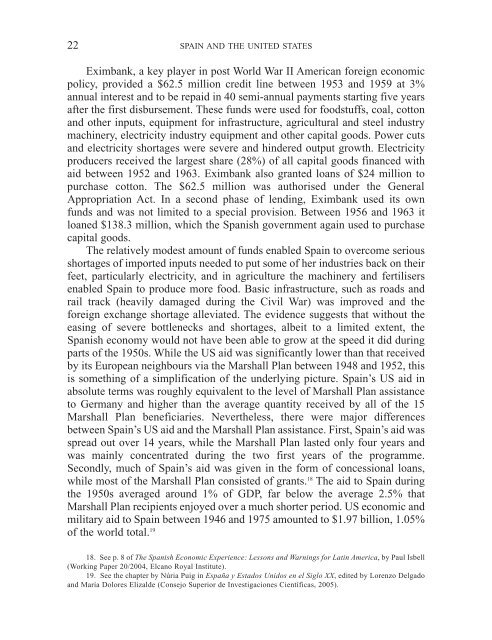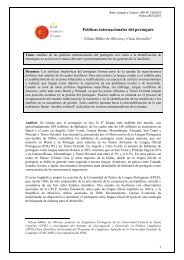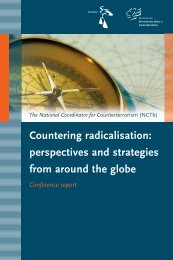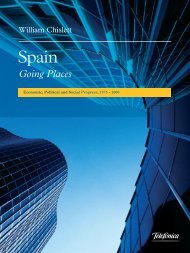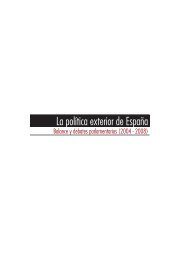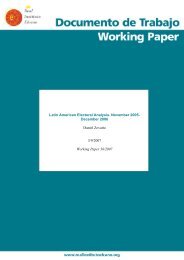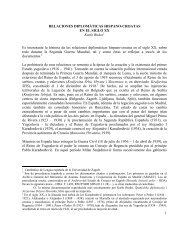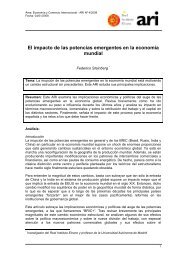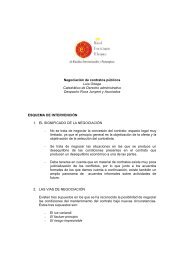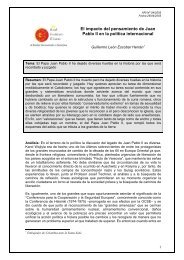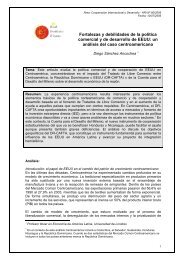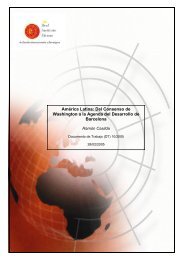Spain and the United States - Real Instituto Elcano
Spain and the United States - Real Instituto Elcano
Spain and the United States - Real Instituto Elcano
Create successful ePaper yourself
Turn your PDF publications into a flip-book with our unique Google optimized e-Paper software.
22<br />
SPAIN AND THE UNITED STATES<br />
Eximbank, a key player in post World War II American foreign economic<br />
policy, provided a $62.5 million credit line between 1953 <strong>and</strong> 1959 at 3%<br />
annual interest <strong>and</strong> to be repaid in 40 semi-annual payments starting five years<br />
after <strong>the</strong> first disbursement. These funds were used for foodstuffs, coal, cotton<br />
<strong>and</strong> o<strong>the</strong>r inputs, equipment for infrastructure, agricultural <strong>and</strong> steel industry<br />
machinery, electricity industry equipment <strong>and</strong> o<strong>the</strong>r capital goods. Power cuts<br />
<strong>and</strong> electricity shortages were severe <strong>and</strong> hindered output growth. Electricity<br />
producers received <strong>the</strong> largest share (28%) of all capital goods financed with<br />
aid between 1952 <strong>and</strong> 1963. Eximbank also granted loans of $24 million to<br />
purchase cotton. The $62.5 million was authorised under <strong>the</strong> General<br />
Appropriation Act. In a second phase of lending, Eximbank used its own<br />
funds <strong>and</strong> was not limited to a special provision. Between 1956 <strong>and</strong> 1963 it<br />
loaned $138.3 million, which <strong>the</strong> Spanish government again used to purchase<br />
capital goods.<br />
The relatively modest amount of funds enabled <strong>Spain</strong> to overcome serious<br />
shortages of imported inputs needed to put some of her industries back on <strong>the</strong>ir<br />
feet, particularly electricity, <strong>and</strong> in agriculture <strong>the</strong> machinery <strong>and</strong> fertilisers<br />
enabled <strong>Spain</strong> to produce more food. Basic infrastructure, such as roads <strong>and</strong><br />
rail track (heavily damaged during <strong>the</strong> Civil War) was improved <strong>and</strong> <strong>the</strong><br />
foreign exchange shortage alleviated. The evidence suggests that without <strong>the</strong><br />
easing of severe bottlenecks <strong>and</strong> shortages, albeit to a limited extent, <strong>the</strong><br />
Spanish economy would not have been able to grow at <strong>the</strong> speed it did during<br />
parts of <strong>the</strong> 1950s. While <strong>the</strong> US aid was significantly lower than that received<br />
by its European neighbours via <strong>the</strong> Marshall Plan between 1948 <strong>and</strong> 1952, this<br />
is something of a simplification of <strong>the</strong> underlying picture. <strong>Spain</strong>’s US aid in<br />
absolute terms was roughly equivalent to <strong>the</strong> level of Marshall Plan assistance<br />
to Germany <strong>and</strong> higher than <strong>the</strong> average quantity received by all of <strong>the</strong> 15<br />
Marshall Plan beneficiaries. Never<strong>the</strong>less, <strong>the</strong>re were major differences<br />
between <strong>Spain</strong>’s US aid <strong>and</strong> <strong>the</strong> Marshall Plan assistance. First, <strong>Spain</strong>’s aid was<br />
spread out over 14 years, while <strong>the</strong> Marshall Plan lasted only four years <strong>and</strong><br />
was mainly concentrated during <strong>the</strong> two first years of <strong>the</strong> programme.<br />
Secondly, much of <strong>Spain</strong>’s aid was given in <strong>the</strong> form of concessional loans,<br />
while most of <strong>the</strong> Marshall Plan consisted of grants. 18 The aid to <strong>Spain</strong> during<br />
<strong>the</strong> 1950s averaged around 1% of GDP, far below <strong>the</strong> average 2.5% that<br />
Marshall Plan recipients enjoyed over a much shorter period. US economic <strong>and</strong><br />
military aid to <strong>Spain</strong> between 1946 <strong>and</strong> 1975 amounted to $1.97 billion, 1.05%<br />
of <strong>the</strong> world total. 19<br />
18. See p. 8 of The Spanish Economic Experience: Lessons <strong>and</strong> Warnings for Latin America, by Paul Isbell<br />
(Working Paper 20/2004, <strong>Elcano</strong> Royal Institute).<br />
19. See <strong>the</strong> chapter by Núria Puig in España y Estados Unidos en el Siglo XX, edited by Lorenzo Delgado<br />
<strong>and</strong> María Dolores Elizalde (Consejo Superior de Investigaciones Científicas, 2005).


